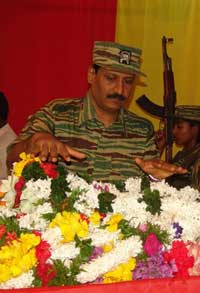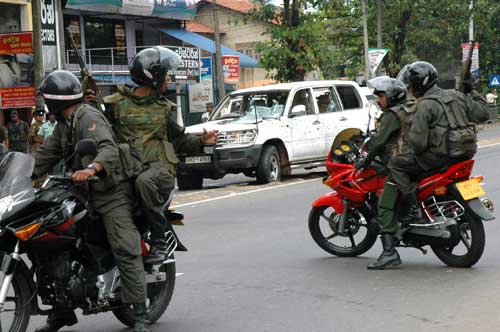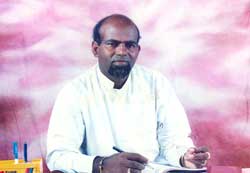
Charles: LTTE's prince of faceless terror
Almost 17 years ago, the assassination of then Deputy Minister of Defence, Ranjan Wijeratne, highlights the detailed planning by Tiger guerrillas to target VIPs. He lived in a house in Colombo's Havelock Road, opposite the Burgher Recreation Club (BRC) and Pedris Park. When he travelled to office or for other engagements in the City, he dissuaded his security detail from taking devious routes to his destination. After exiting home and coming on to Havelock Road, he preferred to proceed direct to Bambalapitiya junction. It is from here that his motorcade branched out to wherever they were heading. Taking Dickman's Road or the Thimbirigasyaya Road was taboo. There were occasions when the security detail took those routes and were ordered to fall back to Havelock Road. The only exception was when he travelled in a southerly direction along Havelock Road, particularly to Deraniyagala. He planned to contest from this electorate, which he was nursing. None was aware that a Tiger guerrilla leader had deployed his men to mount surveillance on the late Mr. Wijeratne. Over a period of time, they constructed a full picture of his routine. At the time of his departure, Police patrol cars would be near BRC premises and at the Dickman's Road junction. Down the road, at Thimbirigasyaya Junction, a Police security detail was present. Further away was the Police Field Force headquarters. Thus, an area that appeared not secured was outside the University Hostel, across the road from the entrance to Police Park. On March 3, 1991, Tiger guerrillas exploded a powerful bomb there killing Mr. Wijeratne. Since then, over the years the same guerrilla leader masterminded several attacks. After he planned and executed the attack on the Central Bank on January 31, 1996, LTTE leader Velupillai Prabhakaran, reports said, bestowed a Pajero vehicle upon him. In that attack, guerrillas rammed a truck loaded with explosives killing 91 people. Other attacks he directed in the past years, almost all of them in the City of Colombo, are too many to catalogue.
On Saturday (January 5), a team from the Army's Long Range Reconnaisance Patrol (LRRP) caught up with this guerrilla leader. Moving stealthily behind the guerrilla lines at Pallamadu in Mannar, they shot him dead. How they boldly executed this task cannot be described in detail for that would expose their operational procedures. Even the Liberation Tigers of Tamil Eelam (LTTE) admitted that it was a great loss to them. Shanmuganathan Ravi Shankar alias Ravichandran alias Ravi alias "Colonel" Charles was head of "Liberation Tigers Military Intelligence" (LTMI). He caught up with his death whilst assisting Sea Tiger leader Soosai (Thillaiampalam Sivanesan). Intelligence sources said his task in the recent weeks was to fortify the Sea Tiger base at Viduthaltivu. The LTTE fears the Army's ongoing offensives in the area include plans to capture this base. The attack on "Col." Charles is indeed a very significant one for the Army, the security and defence establishment. How important he was can be gauged by remarks made by Soosai at the funeral last Sunday. Speaking at a ceremony at the sprawling LTTE "Heroes" cemetery in Puthukudiyiruppu, Tamilnet website quoted Soosai as saying: "Col. Charles was known only to a few but the enemy knew his identity. "When the enemy occupied Jaffna peninsula and was roaming around freely, it was difficult for our cadres to find accommodation and meals. It was during that difficult time Col. Charles functioning under the leadership of Captain Morris, who was in charge of Point Pedro area, faced the military offensives of the Indian Peace Keeping Force (IPKF). He was later sent to Manalaru (Weli Oya) where he coordinated a number of attacks. A short while later he returned to Jaffna peninsula and continued his activities together with LTTE Intelligence Unit Head Pottu Amman. "In 1990 Col. Charles who was in charge of Vadamaraadchi area up to that time of withdrawal of IPKF was identified by Pottu Ammaan, Head of our Intelligence Unit, as the ideal candidate to prepare a base in the South to stage attacks from there. Stationing himself in the South Col. Charles staged a series of successful attacks. "He successfully led a number of daring attacks but once he sensed that he was being wanted by the enemy he quickly changed his place of operation to Batticaloa from where he continued to launch many more successful attacks against the enemy. "During 2001 Katunayake Air Port attack which was flawlessly executed making sure none of the civilian passengers including foreigners were not hurt, this great hero Charles who led the attack proved to the world how effectively he trained the Black Tigers under the guidance of Pottu Amman and also showed to the world community the great power of and discipline of our fighters.
"But for our people he was a faceless commander. During the early stages of his involvement in our movement, Charles functioned under me. At that time while executing his own responsibilities he created a team of Black Tigers to function incognito for attacks to be staged not only in the North and East but also on certain targets in the South. According to my request, Charles created this incognito Black Sea Tiger Unit for attacks in the South…….. "He was not only an expert in staging military offensives but he also had a talent of freely mixing with each and everyone. He developed a cordial relationship with our national leader. He did not restrict his unique style of attacks to the south but making use of the cadres of the newly created Liberation Tigers Military Intelligence (MI) he led attacks in Mukamaalai smashing the Forward Defence Lines (FDLs)……" Unlike many others in the armed forces including their units, whose heroic deeds can be made public, the bravery and valour of the men of the LRRP units, who make a great sacrifices cannot be divulged. In this instance, their mission to penetrate deep into guerrilla-dominated territory overcoming all odds to accomplish targets is not only remarkable but also very significant. Their actions are quite different from other military missions where sometimes opportunity targets are unexpectedly accomplished. They are assigned to dedicated targets on the basis of verified intelligence. Questions are being raised in Colombo's intelligence community as to why LTTE leader, Velupillai Prabhakaran, did not visit his slain military intelligence leader's home in Kilinochchi to pay his respects. A few believed this was because he was injured during the recent Air Force bomb attack and could not travel. However, other well-informed sections said this was purely on grounds of personal security. One of them who did not wish to be identified declared, "The fear of LRRP teams lurking around is causing a big worry for LTTE leaders in the Wanni. So the guerrilla leader will not take a chance to move around." The assault on Charles in the Mannar area came as the Army continued their advance north of the general area in the past several days. There has been a string of sporadic skirmishes with Tiger guerrillas in the recent days. Constraints prevent me from giving details except to add that a senior Army official told a top-level conference he was confident the Madhu church area would be under their control within the next two weeks. He said the troops were within six to seven kilometres from the Church area. The military campaign to gain control of this area and its environs began in July, last year. Efforts by seven battalions in Muhamalai in November, last year, to march southwards in the direction of Kilinochchi met with stiff resistance. Troops were forced to pull back.
Whilst the thrust continues, troops also engaged guerrilla positions south of the defended localities at Muhamalai - the gateway to the Jaffna peninsula. The troops want to seize guerrilla-dominated territory in the area. Highly placed Army sources say troops have also opened a new front in a location north of the Weli Oya sector. These sources declined to give details saying it was "premature" but added that troops have advanced considerably in the direction of guerrilla-dominated territory somewhere near the north eastern coast. The stepped up campaign comes in the light of Government's declared objective of defeating the Tiger guerrillas before the end of this year. Army Commander Lt. Gen. Sarath Fonseka told his annual media dinner at General's House in the heavily guarded Bauddhaloka Mawatha on Friday night that he would not leave the battle against the guerrillas to a successor. He said he would finish the war within this year. The New Year's eve pronouncement of stepping up the military campaign appears to have drawn its own response from the guerrillas. Their latest victim in a claymore mine attack was Puttalam district Parliamentarian and non-Cabinet rank Minister for Nation Building, D.M. Dassanayake. He was on his way to Parliament when his vehicle was hit by the mine at Ja-ela. The incident occurred near the statue of the late film idol Rukmani Devi. He succumbed to his injuries at the Ragama hospital. One of his bodyguards also died later. On the day of the incident, the Terrorism Investigation Division had warned a member of the household of Jeyaraj Fernandopulle, Minister of Highways, Road Development and Chief Government Whip, about a guerrilla cadre moving around in that area. They informed the Police and the suspect was arrested near the Minister's house. He was to later confess that he had been asked by guerrilla intelligence leaders in the Wanni to conduct reconnaissance on Mr. Fernandopulle's house and about his movements. The claymore mine attack in Ja-ela prompted Defence Secretary, Gotabhaya Rajapaksa, to telephone Police Chief, Victor Perera in Colombo. He discussed immediate measures to deploy a large strength of Police and Home Guards in the Greater Colombo area to strengthen security. Part of these measures, including the induction of more Police Special Task Force (STF) commandos, has already come into effect. Last Wednesday Mr. Perera gave the National Security Council a briefing on recent incidents in the City, the prevailing security situation and measures taken by the Police. Two explosions in the City - one on Tuesday - on a phone booth along the end of Sir Chittampalam Gardiner Mawatha caused a loud explosion heard a few miles away. The phone booth was badly damaged and window panes of some apartments at Regent Flats were shattered. A Navy sailor travelling in a three wheeler scooter taxi and the driver of a courier service van suffered shock and were treated at the Colombo National Hospital. The second explosion occurred on Friday night inside the Fort Railway Station. One passenger sustained minor injuries. The bomb, concealed inside a parcel, had been placed on a stairway. Security authorities are confused by these two bombs. They were packed with explosives (without steel balls) and both were exploded through a timing mechanism. "If it was done by the LTTE," an intelligence source said, "it may be only to cause panic but not to lead to casualties. But we cannot conclusively say that until the investigations are complete." If indeed Tiger guerrillas were responsible, one of the aims would be to create fear and panic. It is easy to create both if one is to look at the aftermath. Reports circulated worldwide, not to mention within Sri Lanka, that bombs were exploding in rapid succession in the capital Colombo. Foreign Governments were re-examining travel advisories to their respective citizens. Tour operators were examining how safe it was to send tourists to Sri Lanka. Corporate bodies overseas were assessing the threats to their own business interests in Sri Lanka in the light of an uncertain security situation. The explosions came as Government was readying to ban the LTTE after the Ceasefire Agreement ends on January 16. The explosion may also lead to major search operations in various parts of the City of Colombo by the security forces and the Police. In the light of the stepped up military offensives on Tiger guerrillas, the Ministry of Defence is taking steps to ensure all equipment and other military needs are met. Last week, an Air Force transport plane flying in defence supplies made a stop over in an Asian country. Its takeoff had been delayed after one of the pilots was not available. An inquiry is now under way to ascertain the circumstance. Some reports said he had adjourned to a restaurant for refreshments. Unidentified persons had drugged him there and escaped with his money leaving behind only his identity card. Air Force officials remained tight lipped about the incident. As tougher security measures are falling into place in Colombo, the public, no doubt will have to gear themselves to cope with them. With the return of the checkpoints coupled together with searches, greater vigilance becomes inevitable. The guerrillas will continue to try to make them ineffective. |
|| Front
Page | News | Editorial | Columns | Sports | Plus | Financial
Times | International | Mirror | TV
Times | Funday
Times || |
| |
Reproduction of articles permitted when used without any alterations to contents and the source. |
© Copyright
2008 | Wijeya
Newspapers Ltd.Colombo. Sri Lanka. All Rights Reserved. |



